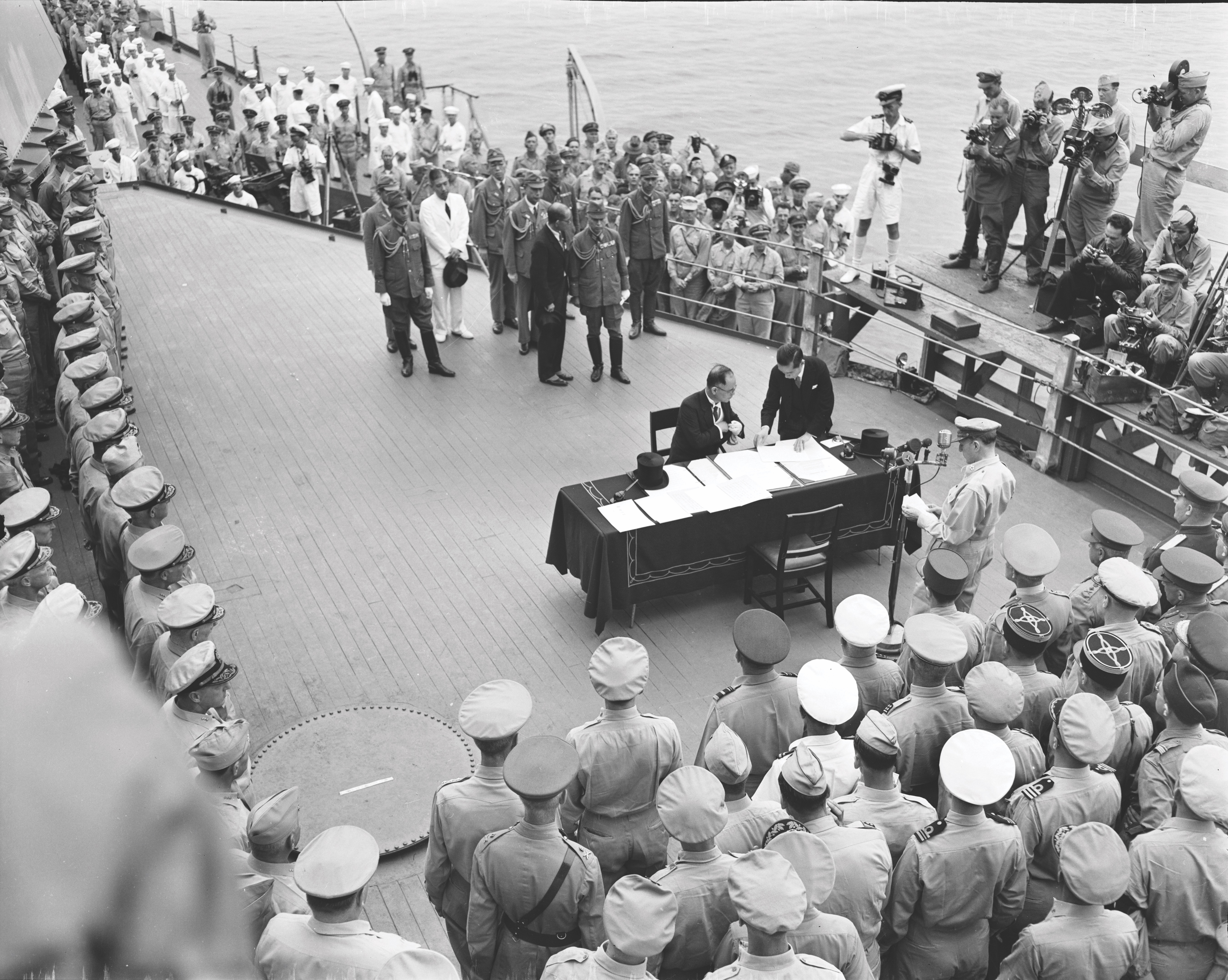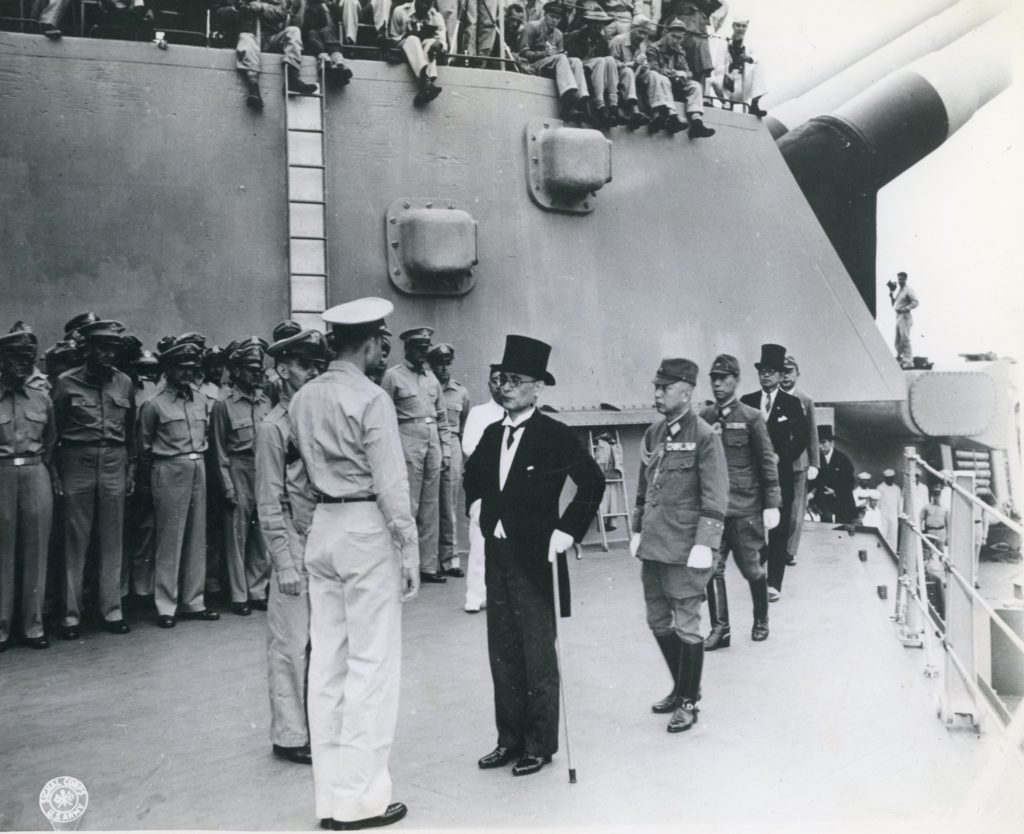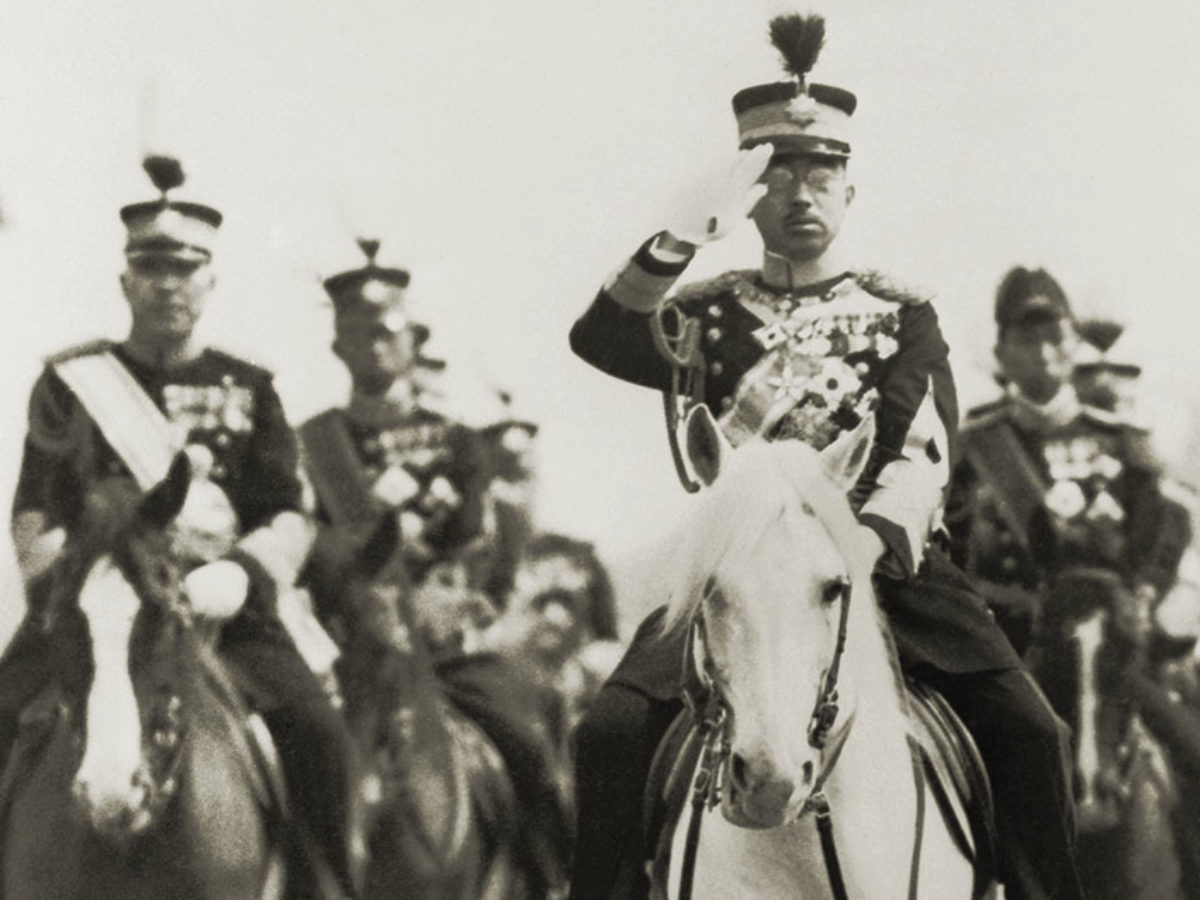In 1942 Theodore L. “Ted” Deglin left his job as public relations director for Madison Square Garden in New York City to enter the U.S. Army, which put him to work as a PR officer at the rank of lieutenant colonel. In September 1945 he found himself a witness to the Japanese surrender aboard the USS Missouri and at Baguio, in the Philippines. Deglin was later promoted to colonel and was awarded the Legion of Merit for his service in the western Pacific. After World War II he returned to the public relations business in New York City. He died there in 2000 at age 92.
The narrative that follows is adapted from Deglin’s five-page, typewritten account of the ceremony (courtesy of John Ptak, a bookseller in Hendersonville, North Carolina).
OKINAWA AFTER DARK IS LIKE ANY OF THE OTHER PACIFIC ISLANDS—perhaps the night air is cooler, but it is the same black expanse of airstrip, the same lonesomeness, and the same mud and dismal tents with their glaring single, unshaded bulbs.
I came in to Okinawa on a B-24, waited for about seven hours, and took off in a C-46 for Atsugi Airstrip, 30 miles from Yokohama. We arrived at Atsugi about 0730, Friday, 31 August. We circled around for a while over the area and got a good look at the part of Honshu, the largest of the Japanese Islands. Two things left strong impressions on me[. F]irstly the great extent of the use of the island: Every bit of the country as far as the horizon was cultivated in tiny patches—not a foot wasted. Another thing was the fact that the rail lines had not been damaged—electric engines were pulling long strings of cars on main lines and spurs.
We taxied in on a rather rough strip. As we stepped out, slightly worried about what would happen (the first airborne troops had landed only 23 hours earlier), to all intents and purposes [we] might just as well have been back in New Jersey or Pennsylvania.
Looking across at the hangar line we saw the buildings in various stages of construction (no bombing damage); more than a hundred big C-54s that had brought the first occupation troops in; a fair amount of American heavy equipment, tank trailers, etc.; and a long line of Jap vehicles, some painted light brown, some black, and the rest a funny gray. Buzzing all around them, running when a walk would do just as well, were the drivers—short, skinny Japs, wearing army caps, nondescript coats, baggy pants, and wraparound puttees like the ones our soldiers wore in World War I.
We found the GHQ [General Headquarters] had moved that morning from a hangar at the field to Yokohama, so we commandeered a bus for the trip in. We picked the best- looking job of the lot, but that only meant that we were about one step ahead of the junk man. Our driver didn’t understand English. He did understand “Yokohama,” so we got in our charcoal-burning chariot (the boiler on the back was really a production!) and spit, wheezed, and smoked our way up a narrow, bumpy road that, when our own vehicles come in, won’t stand up under the pounding for a week.
GET HISTORY’S GREATEST TALES—RIGHT IN YOUR INBOX
Subscribe to our Historynet Now! newsletter for the best of the past, delivered every Wednesday.
The outskirts of Yokohama were pretty badly burned out—napalm, the incendiary bomb element, really did a job. The precision pinpoint bombing was amazing; factories were knocked out, while residential districts were not too badly damaged. The streets of Yokohama itself were nearly deserted of civilians. Dark uniformed gendarmes, the civilian police, were very much in evidence. All of them wear short nickel-plated swords. They were polite, and many of them saluted as we drove by. We saw quite a few Jap soldiers, practically all of them armed to the teeth. They ignored us.
Some of the buildings in town are burned out, but it is surprising the number of untouched. In a single block two or three buildings may be destroyed and the ones next to them damaged not at all, or only slightly. Shops are all closed. As a matter of fact, they have been for a long time. Yokohama was a military area. Most of the civilians had been evacuated, and all efforts of those remaining were in direct support of the war.
ALL OF THE BRASS IN YOKOHAMA, AND THERE W[ERE] PLENTY IN TOWN for the surrender ceremony, w[ere] billeted at the New Grand Hotel. With clean, luxurious rooms, good chow, good service, the top-flight boys were kept quite happy. I have never seen so many stars in my life; major generals—three star, four star officers, brilliant uniforms of the Allied powers—it was quite a show just to stand in the lobby.
Sunday morning at 0600 the correspondents (and I) climbed aboard a destroyer in the harbor and headed for the Missouri, anchored in Tokyo Bay, 12 miles out. There were about 200 of us. These were just the army-accredited boys; the navy had about the same number. We had all drawn positions for the ceremony, which was to be held on the veranda deck of the ship, just forward of the bridge. I had drawn position ABLE, which was on the gun turret. It was a good spot and I got some excellent pictures with my little camera.
When we were settled down in our spots, the brass started arriving. Fifty generals and 50 admirals represented our armed forces. Then came the Chinese, British, Russian, Australian, Canadian, French Netherlands, and New Zealand representatives, their top army, navy, and air corps brass. They lined up facing the bow just a short distance behind a long narrow table, which had one chair on each side. Between the Allied representatives and the table was a standing microphone which was to be used by General [Douglas] MacArthur.
All of the Allied powers representatives had come in by destroyer. When a lot of buzzing started that the Japanese delegation was arriving, we looked for a destroyer and saw none near; we looked again and saw a little barge approaching—not much bigger than a big rowboat, and it was loaded with silk-hatted, gold-braided, glum-faced Japs. The psychological effect of such arrival was tremendous.
The Japs came aboard and lined up facing the Allied group, across the table from them. Then General MacArthur and Admiral [Chester W.] Nimitz made their grand appearance. The general took his place at the microphone stand, the admiral at the extreme right of the Allied lineup.
Recommended for you
GENERAL MACARTHUR IS A TERRIFIC SHOWMAN. Every move of his is dramatic and beautifully timed. He spoke briefly, then instructed the Jap foreign minister to sign for the emperor of Japan and the Japanese government. The skinny, bespectacled, top-hatted minister, [Mamoru] Shigemitsu, limped forward, pulling his game leg after him. He sat down, facing MacArthur, and had trouble getting the leg under the table. He fiddled around, picked up a pen, put it down, looked at his watch, looked around, looked at his watch again until everyone was slightly nervous, and the general looked quite irritated. Frankly, I could think of only one thing: that a kamikaze plane was going to dive out of the clouds at this time and blow us all over Tokyo Bay. No such excitement, however; the old boy signed both copies of the surrender document and limped back to his position. Then General [Yoshijiro] Umezu, chief of staff for the Imperial Japanese Army, signed quickly.
General MacArthur then signed as supreme commander of the Allied forces, first calling Generals [Jonathan M.] Wainwright and [Arthur] Percival (the latter the British officer who surrendered his troops at Malay) to stand on either side of him. He pulled a half-dozen pens from his pocket and signed with three of them, giving one to Wainwright, one to Percival, and the third he put in his pocket. Then Admiral Nimitz signed for the United States, followed by the official representatives of China, United Kingdom, Soviet Union, Australia, Canada, France, the Netherlands, and New Zealand.
The ceremony was then proclaimed concluded. The Japanese delegates left immediately but not until Shigemitsu had been given the supreme commander’s general orders, which among other things, told the Japanese to liberate all Allied war prisoners, preserve all industrial plants, and, the most important of all, to acknowledge that the authority of the Japanese emperor and the Japanese government is subject to the will of the supreme Allied commander.
All of the correspondents made a beeline for our waiting destroyer, and we steamed at 27 knots back to Yokohama. It was about 0950, and the release time for the story was 1030. I was scheduled to meet generals Wainwright and Percival at the Grand Hotel, for I had been designated to accompany them back to the Philippines, Manila, then Baguio, up in the mountains, for the surrender to the CG, AFWESPAC [Commanding General, U.S. Army Forces, Western Pacific] of Lieutenant General [Tomoyuki] Yamashita and all of his forces in the Philippines.
At Atsugi airport we picked up my boss, Lieutenant General [Wilhelm] Styer. We were advised that the route back, through Okinawa, was in a typhoon path, so we flew to Iwo Jima first. After an hour’s layover, we took off for Manila, arriving at 0145 Monday. I was to be at the airport at 0630 for the flight to Baguio. The place, a resort one mile high in the mountains of Luzon, is an hour by jeep from the short Naguillian strip and two hours from Luna, a longer strip that a C-47 can land on. Naguillian is 140 air miles from Manila; Luna is 155.
In the morning I picked up Howard Pyle, NBC commentator, and headed for Nielsen Field. With one delay or another we were late, and I missed the party which again included my CG. I scurried around and commandeered a C-64—a single-motor, six-place job. We came in at Naguillian, while the others, who had a 15-minute start on us, had to go to Luna. We grabbed a jeep and had a rough and thrilling ride up the mountain—landslides ahead of us and behind us; roads, bridges washed out or bombed out; precipitous drops about a half mile deep—it was really a motion picture cowboy and Indian trip.
We arrived at Baguio, past long lines of MPs and a good half hour before the party of generals. The ceremony took place at the commissioner’s house, which was slightly damaged by shelling. The place reminded me of Madison Square Garden just before some big event. Correspondents were milling around, teletype machines clicking away. Typewriters all over the place, flash bulbs going off on all sides, things were really popping! The public relations staff of AFWESPAC (my boys) had the situation well in hand.
I went upstairs to see Yamashita, who is a cool old baby. He was being photographed and sketched by an artist and seemed to love it. All of the swords taken away from the Jap officers were laid out on a table near the conference room. They made quite a display. I tried to earmark one but didn’t make the grade.
Generals Styer, Wainwright, and Percival came in and were surprised to find me waiting for them. Major General [Edmond H.] Leavey, our chief of staff, was taking the surrender because General Styer had not been expected back from Tokyo Bay.
The conference room was set up with a long table. On one side were a dozen high, hand-carved chairs. On the other side were four wooden folding chairs. The newsreel cameras, still photographers, and radio broadcasters were all set up in their places. Then the Japs were brought in. They were led to the side of the table where the small chairs were and started to sit down but were instructed to remain standing. They were kept standing for nearly 10 minutes; then the top generals came in and sat down. After them came a group of 15 brigadier and major generals. Then the correspondents were herded in—about 35 of them.
The ceremony was partially designed for the radio broadcast. The surrender document was read, Yamashita was asked if he understood the terms (an interpreter stood behind him), he answered “yes,” the documents (four copies) were signed, the generals filed out, and Yamashita was turned over to the MPs for delivery to New Bilibid Prison near Manila. Incidentally, when he left Baguio he wore a string of ribbons. Guess who has them now!
We flew back to Manila in a C-64, found a big crowd at Nielsen Field waiting for Wainwright and a look at Yamashita. Both surrenders were accomplished in most impressive manner and have now been written as a fitting finish to this long, hard war.

this article first appeared in military history quarterly
Facebook: @MHQmag | Twitter: @MHQMagazine








